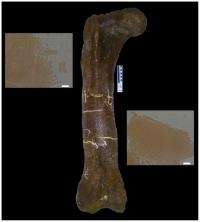June 15, 2011 report
New evidence backs up claim of dinosaur soft tissue find

(PhysOrg.com) -- In a new study, biochemist James San Antonio and colleagues offer evidence to support the claims by Mary Higby Schweitzer back in 2005, that she and her colleagues had unearthed a soft tissue specimen that belonged to a Tyrannosaurus rex. Roundly criticized by many in the science community, the specimen, discovered inside a femur fragment, has yet to be proven to be anything else. Now, in a paper published on PLoS ONE, San Antonio and his colleagues (including Mary Schweitzer) claim they’ve found a plausible explanation for the survival of soft dinosaur material after some 68 million years.
The team focused on bits of collagen found in the remains, which are a group of proteins found in the flesh and bones of animals; it grows in a triple helix, which when it winds together, is known as a microfibril. When thousands of microfibril wind together, as they often do, they are known as microfibrils.
After carefully studying 11 fragments of collagen recovered from the T. rex bone and then comparing them to similar fragments in modern rat and human collagen, the team discovered that the found fragments all came from the same innermost part of the fibrils that make up microfibrils. San Antononio likens them to tiny fibers that sit at the very innermost part of a very thick strong rope.
In their paper, the research team suggests that because they were so tightly wound, the microfibrils could have survived over millions of years. They also note that the specimens also contained very few amino acids, which are very susceptible to decay.
To back up her claims, or to quiet the naysayers, Schweitzer points out that if the specimens found were actually contaminants from other more recent organisms, as some have claimed, there should have been more randomness to the collagen, instead of the strict uniformity that was found. She also notes that two other labs have corroborated her results.
The unfortunate side story to all the research done so far though, including these latest findings, is that thus far there is no way to definitively prove whether the soft tissue found inside that T. rex bone was in fact a remnant from its original owner, or something that came after. Thus, claims from both those supporting the idea that dinosaur tissue could have survived for millions of years, and those that think it’s nonsense, are likely to continue.
More information: San Antonio JD, Schweitzer MH, Jensen ST, Kalluri R, Buckley M, et al. (2011) Dinosaur Peptides Suggest Mechanisms of Protein Survival. PLoS ONE 6(6): e20381. doi:10.1371/journal.pone.0020381
Abstract
Eleven collagen peptide sequences recovered from chemical extracts of dinosaur bones were mapped onto molecular models of the vertebrate collagen fibril derived from extant taxa. The dinosaur peptides localized to fibril regions protected by the close packing of collagen molecules, and contained few acidic amino acids. Four peptides mapped to collagen regions crucial for cell-collagen interactions and tissue development. Dinosaur peptides were not represented in more exposed parts of the collagen fibril or regions mediating intermolecular cross-linking. Thus functionally significant regions of collagen fibrils that are physically shielded within the fibril may be preferentially preserved in fossils. These results show empirically that structure-function relationships at the molecular level could contribute to selective preservation in fossilized vertebrate remains across geological time, suggest a ‘preservation motif’, and bolster current concepts linking collagen structure to biological function. This non-random distribution supports the hypothesis that the peptides are produced by the extinct organisms and suggests a chemical mechanism for survival.
© 2010 PhysOrg.com



















